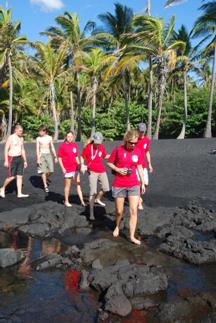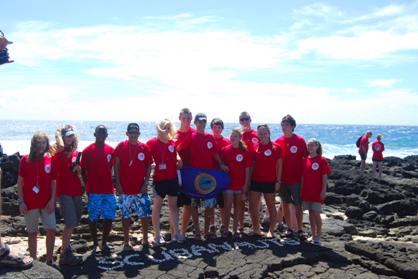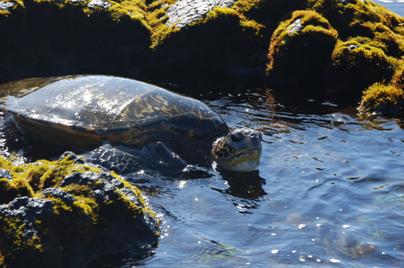There is much exciting wildlife below the water, as you will see below, and some beautiful pictures! Again — you might want to look on the Web for more images of some of the sea creatures the bloggers saw.
Notice that we could estimate the air pressure the climbers were experiencing on Mauna Kea. What about the pressure below the water? A rule of thumb is that the pressure increases by about one atmosphere (1013 hectoPascals or hPa) for each 10 m below the surface. While the Operation Deep Climb hikers were experiencing an air pressure of around 696 hPa at 3200 m elevation, the SNI articipants were experiencing a total pressure of:
1013 hPa (from the air) + 1013 hPa/10 meters times 15 meters (or 1519.5 hPa)= 2543 hPa 15 meters below the ocean surface. |
You can feel air pressure changes if you go up or down quickly in an elevator, in airplane, or on a mountain road: your ears “pop” as pressure from the inside and outside balance. (The air inside a commercial aircraft at cruising altitude is pressurized so that the pressure is about 15% lower than at sea level — much higher of course than it is outside!)
Day 5 – 15 October 2007
Madison
SNI participant
We went to a black sand beach. The most durable minerals survived when the lava flows are eroded, they wash up on the beach, forming black sand. There were many turtles on the rocks.

Then we went to the southern-most point of the U.S. It was a cliff that dropped off into the Pacific.

Later we did our first dive in Hawaii! The first dive was in Garden Eel Cove, it was a 40 minute dive at 50 feet (15 meters). We saw a garden eel and lots of urchins. The coral was really pretty. Our second dive, a night dive, was also at Garden Eel Cove. It was an hour long and at 40 feet. We sat at the bottom in a circle, and huge manta rays came overhead. Sometimes they got really close to the top of your head. They were 15-20 feet (4.6 – 6.1 meters) across, and the baby was about 6 feet (1.8 meters). Their mouths were about a foot across (0.3 meters). The water was turbulent because the rays were disrupting it while swimming around. They came to the lights to feed on the light-attracted plankton.
Connor
SNI participant
The black sand beach was incredible! We saw many crabs, fish, and even a baby eel in one of the tide pools, and a couple of turtles resting on the beach.

We also had our first dives of the trip today, our first dive was o.k. we got to swim around and see garden eels, colorful reefs, and fish.
But, the first dive was nothing compared to the second dive, which was the most amazing dive I’ll ever go on! It was the manta ray dive, which was so awesome. We got about 10 manta rays, which is pretty good the captain said, because sometimes they don’t get any. But, it was the coolest thing ever!
